
A coin is a small object, usually round and flat, used primarily as a medium of exchange or legal tender. They are standardized in weight, and produced in large quantities at a mint in order to facilitate trade. They are most often issued by a government. Coins often have images, numerals, or text on them. The faces of coins or medals are sometimes called the obverse and the reverse, referring to the front and back sides, respectively. The obverse of a coin is commonly called heads, because it often depicts the head of a prominent person, and the reverse is known as tails.
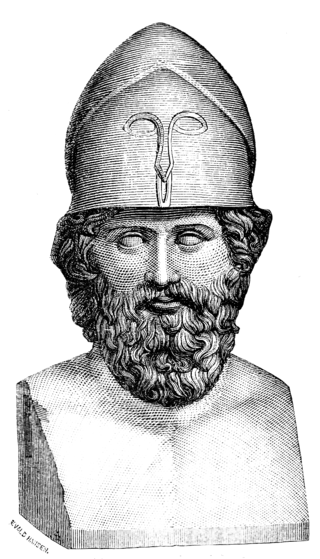
Themistocles was an Athenian politician and general. He was one of a new breed of non-aristocratic politicians who rose to prominence in the early years of the Athenian democracy. As a politician, Themistocles was a populist, having the support of lower-class Athenians, and generally being at odds with the Athenian nobility. Elected archon in 493 BC, he convinced the polis to increase the naval power of Athens, a recurring theme in his political career. During the first Persian invasion of Greece, he fought at the Battle of Marathon, and may have been one of the ten Athenian strategoi (generals) in that battle.

A satrap was a governor of the provinces of the ancient Median and Achaemenid Empires and in several of their successors, such as in the Sasanian Empire and the Hellenistic empires. A satrapy is the territory governed by a satrap.
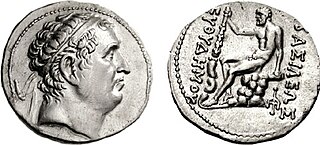
Euthydemus Ic. 260 BC – 200/195 BC) was a Greco-Bactrian king and founder of the Euthydemid dynasty. He is thought to have originally been a satrap of Sogdia, who usurped power from Diodotus II in 224 BC. Literary sources, notably Polybius, record how he and his son Demetrius resisted an invasion by the Seleucid king Antiochus III from 209 to 206 BC. Euthydemus expanded the Bactrian territory into Sogdia, constructed several fortresses, including the Derbent Wall in the Iron Gate, and issued a very substantial coinage.

A portrait is a painting, photograph, sculpture, or other artistic representation of a person, in which the face and its expressions are predominant. The intent is to display the likeness, personality, and even the mood of the person. For this reason, in photography a portrait is generally not a snapshot, but a composed image of a person in a still position. A portrait often shows a person looking directly at the painter or photographer, in order to most successfully engage the subject with the viewer.

The Coinage of India began anywhere between early 1st millennium BCE to the 6th century BCE, and consisted mainly of copper and silver coins in its initial stage. The coins of this period were Karshapanas or Pana. A variety of earliest Indian coins, however, unlike those circulated in West Asia, were stamped bars of metal, suggesting that the innovation of stamped currency was added to a pre-existing form of token currency which had already been present in the Janapadas and Mahajanapada kingdoms of the Early historic India. The kingdoms that minted their own coins included Gandhara, Kuntala, Kuru, Magadha, Panchala, Shakya, Surasena, Surashtra and Vidarbha etc.
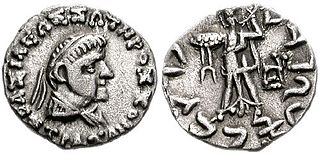
Strato IISoter also known as Stratha, was an Indo-Greek king. He ruled c. 25 BCE to 10 CE according to Bopearachchi. R. C. Senior suggests that his reign ended perhaps a decade earlier. He may have been supplanted by the Indo-Scythian Northern Satraps, particularly Rajuvula and Bhadayasa, whose coins were often copied on those of the last Indo-Greek kings. Numerous coins of Rajuvula have been found in company with the coins of the Strato group in the Eastern Punjab and also in the Mathura area: for example, 96 coins of Strato II were found in Mathura in conjunction with coins of Rajuvula, who also imitated the designs of Strato II in the majority of his issues.

Autophradates was a Persian Satrap of Lydia, who also distinguished himself as a general in the reign of Artaxerxes III and Darius III.

The Achaemenid Empire issued coins from 520 BC–450 BC to 330 BC. The Persian daric was the first gold coin which, along with a similar silver coin, the siglos represented the first bimetallic monetary standard. It seems that before the Persians issued their own coinage, a continuation of Lydian coinage under Persian rule is likely. Achaemenid coinage includes the official imperial issues, as well as coins issued by the Achaemenid provincial governors (satraps), such as those stationed in Asia Minor.
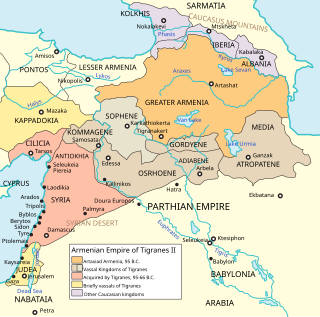
The Kingdom of Sophene, was a Hellenistic-era political entity situated between ancient Armenia and Syria. Ruled by the Orontid dynasty, the kingdom was culturally mixed with Greek, Armenian, Iranian, Syrian, Anatolian and Roman influences. Founded around the 3rd century BCE, the kingdom maintained independence until c. 95 BCE when the Artaxiad king Tigranes the Great conquered the territories as part of his empire. Sophene laid near medieval Kharput, which is present day Elazığ.

The Severe style, or Early Classical style, was the dominant idiom of Greek sculpture in the period ca. 490 to 450 BCE. It marks the breakdown of the canonical forms of archaic art and the transition to the greatly expanded vocabulary and expression of the classical moment of the late 5th century. It was an international style found at many cities in the Hellenic world and in a variety of media including: bronze sculpture in the round, stelae, and architectural relief. The style perhaps realized its greatest fulfillment in the metopes of the Temple of Zeus, Olympia.

The Achaemenid conquest of the Indus Valley refers to a process beginning in the 6th century BCE and ending in the 4th century BCE, whereby the Achaemenid Persian Empire established control over the northwestern regions of the Indian subcontinent, today predominantly comprising the territory of Pakistan. The first of the two main invasions was conducted around 535 BCE by Cyrus the Great, who annexed the areas to the west of the Indus River, consolidating the early eastern border of the Achaemenid Empire. With a brief pause after Cyrus' death, the campaign continued under Darius the Great, who began to re-conquer former provinces and further expand Persia's political boundaries. Around 518 BCE, Persian armies under Darius crossed the Himalayas into India to initiate a second period of conquest by annexing regions up to the Jhelum River in Punjab.

The Thirty-first Dynasty of Egypt, also known as the Second Egyptian Satrapy, was effectively a satrapy of the Achaemenid Persian Empire between 343 BC to 332 BC. It was founded by Artaxerxes III, the King of Persia, after his reconquest of Egypt and subsequent crowning as Pharaoh of Egypt, and was disestablished upon the conquest of Egypt by Alexander the Great.

The Mitra dynasty refers to a group of local rulers whose name incorporated the suffix "-mitra" and who are thought to have ruled in the area of Mathura from around 150 BCE to 50 BCE, at the time of Indo-Greek hegemony over the region, and possibly in a tributary relationship with them. They are not known to have been satraps nor kings, and their coins only bear their name without any title, therefore they are sometimes simply called "the Mitra rulers of Mathura". Alternatively, they have been dated from 100 BCE to 20 BCE. The Mitra dynasty was replaced by the Indo-Scythian Northern Satraps from around 60 BCE.

Strato IIIPhilopator was an Indo-Greek king who ruled c. 25 BCE to 10 CE. He is only known through the joint coins with his father Strato II. He may have been supplanted, in conjunction with his father or later as an independent king, by the Indo-Scythian Northern Satraps, particularly Rajuvula and Bhadayasa, whose coins were often copied. Strato was the last of the line of Diodotus and independent Hellenistic king to rule at his death in 10 AD.

Frataraka is an ancient Persian title, interpreted variously as “leader, governor, forerunner”. It is an epithet or title of a series of rulers in Persis from 3rd to mid 2nd century BC, or alternatively between 295 and 220 BC, at the time of the Seleucid Empire, prior to the Parthian conquest of West Asia and Iran. Studies of frataraka coins are important to historians of this period.
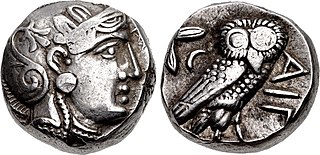
The Kabul hoard, also called the Chaman Hazouri, Chaman Hazouri or Tchamani-i Hazouri hoard, is a coin hoard discovered in the vicinity of Kabul, Afghanistan in 1933. The collection contained numerous Achaemenid coins as well as many Greek coins from the 5th and 4th centuries BCE. Approximately one thousand coins were counted in the hoard. The deposit of the hoard is dated to approximately 380 BCE, as this is the probable date of the least ancient datable coin found in the hoard.
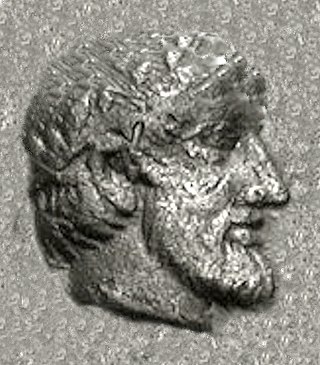
Archeptolis, also Archepolis, was a Governor of Magnesia on the Maeander in Ionia for the Achaemenid Empire circa 459 BCE to possibly around 412 BCE, and a son and successor of the former Athenian general Themistocles.
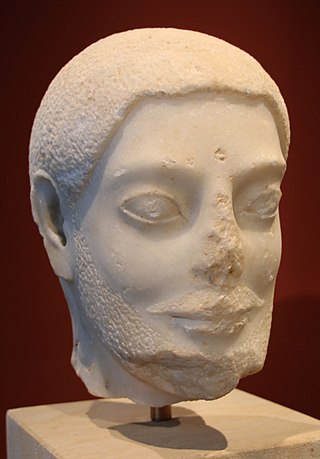
The Sabouroff head is a Late Archaic Greek marble sculpture. It is dated to c. 550–525 BC. This head of a Kouros was named after Peter Alexandrovich Saburov, a collector of ancient Greek sculpture and antiquities. It is 23 centimeters in height. The sculpture is currently located in the Antikensammlung Berlin and allegedly from Attica or Aegina. There are conjectures that it may also have been from Caria in Asia Minor.

Prokles was a descendant of the exiled Spartan king Demaratus, and ruler of Pergamon in Asia Minor under the Achaemenid Empire. He was a brother of Eurysthenes, with whom he was a joint ruler.





















